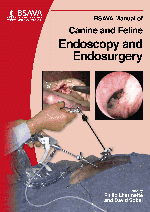
Full text loading...

PLEASE NOTE THAT A MORE RECENT EDITION OF THIS TITLE IS AVAILABLE IN THE LIBRARY
Upper gastrointestinal (GI) endoscopy is one of the most common endoscopic procedures performed in companion animal practice, and encompasses examination of the oesophagus, stomach and proximal small intestine. It is possible to examine the oesophagus with a rigid endoscope (which may also be useful for foreign body removal) but a flexible endoscope is preferred for diagnostic investigation of the oesophagus, and is essential to be able to examine the stomach completely and to intubate the small intestine. And whilst early flexible endoscopes were only able to permit observation of the GI tract, modern gastroscopes can now also be used for sampling tissues and liquids and even for some therapeutic procedures. This chapters describes the Role of endoscopy in investigating GI disease; the Indications; the Contradictions; the Instrumentation; Patient preparation; Premedication and anaesthesia; Patient positioning; Procedure; Rigid oesophagoscopy; Normal findings; Pathological conditions; Foreign body removal; Oesophageal stricture; Percutaneous endoscopic gastrostomy tube placement; Jejunostomy tube placement; and Complications of upper GI endoscopy.
Flexible endoscopy: upper gastrointestinal tract, Page 1 of 1
< Previous page | Next page > /docserver/preview/fulltext/10.22233/9781905319572/9781905319572.4-1.gif

Full text loading...




































